Semiochemicals — Chemical Control of Behavior
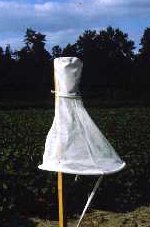 Much of an insect’s behavior is mediated by chemicals in its environment. By turning these chemicals to our own advantage, it is often possible to attract pests to traps or baits, or repel them from our homes, our crops, or our domestic animals. Behavioral messages are delivered by a wide array of chemical compounds. As a group, these compounds are known as semiochemicals. In some cases, they may facilitate communication between the members of a single species (e.g., pheromones) or between members of different species (e.g., allelochemicals). Functionally, semiochemicals may have a wide range of activity. They may serve as attractants or repellents, they may stimulate or inhibit feeding, they may provoke flight or inhibit it, or they may simply elicit behavior patterns at inappropriate times.
Much of an insect’s behavior is mediated by chemicals in its environment. By turning these chemicals to our own advantage, it is often possible to attract pests to traps or baits, or repel them from our homes, our crops, or our domestic animals. Behavioral messages are delivered by a wide array of chemical compounds. As a group, these compounds are known as semiochemicals. In some cases, they may facilitate communication between the members of a single species (e.g., pheromones) or between members of different species (e.g., allelochemicals). Functionally, semiochemicals may have a wide range of activity. They may serve as attractants or repellents, they may stimulate or inhibit feeding, they may provoke flight or inhibit it, or they may simply elicit behavior patterns at inappropriate times.
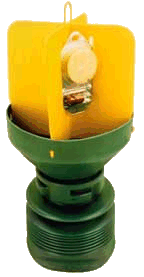 Attractant pheromones and allelochemicals can be used as lures or baits in a wide variety of insect traps, or they can be mixed together with toxicants to produce an “elixir of death”. Protein hydrolysates, for example, serve as feeding attractants for fruit flies (Rhagoletis spp.). These chemicals can be applied to sticky traps to improve catch, or combined with an insecticide and sprayed on fruit crops to suppress active infestations. Phenethyl propanoate, eugenol, and geraniol can be mixed in a 3.5:3.5:3 ratio and used as an attractant for Japanese beetles (Popillia japonica). These are the active ingredients in the “floral attractant” found in popular bag traps for Japanese beetles. In some cases, chemists have produced synthetic compounds that are even more attractive than naturally occurring chemicals. Trimedlure, a synthetic substitute for alpha-copaene, is produced commercially as an attractant for the Mediterranean fruit fly (Ceratitis capitata). Improved food lures and baits are among the most promising new developments for controlling cockroaches (Blattoidea) in homes and businesses. These are the active ingredients in a new generation of “roach motels” where the insects “check in but don’t check out.”
Attractant pheromones and allelochemicals can be used as lures or baits in a wide variety of insect traps, or they can be mixed together with toxicants to produce an “elixir of death”. Protein hydrolysates, for example, serve as feeding attractants for fruit flies (Rhagoletis spp.). These chemicals can be applied to sticky traps to improve catch, or combined with an insecticide and sprayed on fruit crops to suppress active infestations. Phenethyl propanoate, eugenol, and geraniol can be mixed in a 3.5:3.5:3 ratio and used as an attractant for Japanese beetles (Popillia japonica). These are the active ingredients in the “floral attractant” found in popular bag traps for Japanese beetles. In some cases, chemists have produced synthetic compounds that are even more attractive than naturally occurring chemicals. Trimedlure, a synthetic substitute for alpha-copaene, is produced commercially as an attractant for the Mediterranean fruit fly (Ceratitis capitata). Improved food lures and baits are among the most promising new developments for controlling cockroaches (Blattoidea) in homes and businesses. These are the active ingredients in a new generation of “roach motels” where the insects “check in but don’t check out.”
 Sex pheromones are among the most powerful of chemical attractants. Ever since they were first discovered by A. A. Budenandt in 1959 (from silkworm moths, Bombyx mori), these chemicals have aroused great interest because of their potential as pest control agents. During the past 30 years, chemists have identified the sex pheromones for over 300 insect species. Many of these compounds are now sold commercially. In some cases, pheromones are packaged (or encapsulated) in slow-release dispensers (rubber septa, hollow fibers, or rope wicks) that are used as lures in traps of various designs. At low densities, these pheromone traps are a valuable monitoring tool, providing information on the density and distribution of pest populations. At high densities, they can be used for mass trapping sexually active adults (usually males) in efforts to reduce population density and lower a pest’s reproductive potential.
Sex pheromones are among the most powerful of chemical attractants. Ever since they were first discovered by A. A. Budenandt in 1959 (from silkworm moths, Bombyx mori), these chemicals have aroused great interest because of their potential as pest control agents. During the past 30 years, chemists have identified the sex pheromones for over 300 insect species. Many of these compounds are now sold commercially. In some cases, pheromones are packaged (or encapsulated) in slow-release dispensers (rubber septa, hollow fibers, or rope wicks) that are used as lures in traps of various designs. At low densities, these pheromone traps are a valuable monitoring tool, providing information on the density and distribution of pest populations. At high densities, they can be used for mass trapping sexually active adults (usually males) in efforts to reduce population density and lower a pest’s reproductive potential.
 Slow-release formulations of sex pheromones can also be used for mating disruption. By increasing the concentration of pheromone in an insect’s environment, it may be possible to make everything smell like a prospective mate. Males wear themselves out courting inanimate objects or become habituated to the odor and stop responding to it. This approach, variously known as air permeation or the innundation technique, has shown promise for controlling a number of fruit and vegetable pests, including the codling moth (Cydia pomonella), the cabbage looper (Trichoplusia ni), the oriental fruit moth (Grapholita molesta), and the peachtree borer (Synanthedon exitiosa).
Slow-release formulations of sex pheromones can also be used for mating disruption. By increasing the concentration of pheromone in an insect’s environment, it may be possible to make everything smell like a prospective mate. Males wear themselves out courting inanimate objects or become habituated to the odor and stop responding to it. This approach, variously known as air permeation or the innundation technique, has shown promise for controlling a number of fruit and vegetable pests, including the codling moth (Cydia pomonella), the cabbage looper (Trichoplusia ni), the oriental fruit moth (Grapholita molesta), and the peachtree borer (Synanthedon exitiosa).
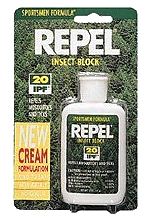 Chemical repellents and feeding deterrents are also useful tools for managing insect behavior. As their name suggests, these compounds cause insects (or other arthropods) to disperse or to discontinue normal feeding behavior. Repellents such as dimethyl phthalate, benzyl benzoate, and N,N-diethyl-m-toluamide (DEET) have been developed to protect humans from biting flies, ticks, and chiggers (immature trombiculid mites). Other compounds, like di-n-butyl succinate or butoxypolypropylene glycol, are used as fly repellents for cattle. Moth balls and flakes (paradicholorobenzene or alpha-naphthalene) are placed in drawers and closets to prevent infestation by a variety of insects that feed on stored products and natural fibers. Woolen cloth can be manufactured with colorless dyes (e.g., Eulans and Mitin FF) that bond permanently to the fabric and make it unpalatable to clothes moths and carpet beetles. Wood preservatives, such as pentachlorophenol, act as feeding deterrents to termites and other wood-dwelling insects.
Chemical repellents and feeding deterrents are also useful tools for managing insect behavior. As their name suggests, these compounds cause insects (or other arthropods) to disperse or to discontinue normal feeding behavior. Repellents such as dimethyl phthalate, benzyl benzoate, and N,N-diethyl-m-toluamide (DEET) have been developed to protect humans from biting flies, ticks, and chiggers (immature trombiculid mites). Other compounds, like di-n-butyl succinate or butoxypolypropylene glycol, are used as fly repellents for cattle. Moth balls and flakes (paradicholorobenzene or alpha-naphthalene) are placed in drawers and closets to prevent infestation by a variety of insects that feed on stored products and natural fibers. Woolen cloth can be manufactured with colorless dyes (e.g., Eulans and Mitin FF) that bond permanently to the fabric and make it unpalatable to clothes moths and carpet beetles. Wood preservatives, such as pentachlorophenol, act as feeding deterrents to termites and other wood-dwelling insects.
 The neem tree, Azadirachta indica (Meliaceae) is a promising new source of feeding repellents that may be developed for use on selected non-crop plants. The leaves, twigs, and seeds of this tree, which is grown commercially in India, contain at least 25 biologically active compounds that act as insect repellents, feeding deterrents, or growth regulators. Azadirachtin, the most abundant of these active ingredients, is now commercially available in the United States. Sold under the trade name Margosan-O, this new feeding deterrent has been approved for use on non-food greenhouse crops, ornamentals, and turf.
The neem tree, Azadirachta indica (Meliaceae) is a promising new source of feeding repellents that may be developed for use on selected non-crop plants. The leaves, twigs, and seeds of this tree, which is grown commercially in India, contain at least 25 biologically active compounds that act as insect repellents, feeding deterrents, or growth regulators. Azadirachtin, the most abundant of these active ingredients, is now commercially available in the United States. Sold under the trade name Margosan-O, this new feeding deterrent has been approved for use on non-food greenhouse crops, ornamentals, and turf.
 Most people understand that chemical pest control involves the use of chemical substances to kill or disrupt the life cycle of an insect pest. But few people outside the circle of entomology realize just how diverse these compounds are, and in how many different ways they can be used. Although conventional insecticides, the poisons, are still a mainstay of chemical control, they are gradually being superseded by less toxic compounds that disrupt insect development or modify behavior. These compounds, broadly known as allelochemicals, tend to be much safer for the environment and more species specific than most conventional insecticides. Allelochemicals can be further subdivided into semiochemicals (which affect behavior), chemosterilants (which affect reproduction), and growth regulators (which affect development).
Most people understand that chemical pest control involves the use of chemical substances to kill or disrupt the life cycle of an insect pest. But few people outside the circle of entomology realize just how diverse these compounds are, and in how many different ways they can be used. Although conventional insecticides, the poisons, are still a mainstay of chemical control, they are gradually being superseded by less toxic compounds that disrupt insect development or modify behavior. These compounds, broadly known as allelochemicals, tend to be much safer for the environment and more species specific than most conventional insecticides. Allelochemicals can be further subdivided into semiochemicals (which affect behavior), chemosterilants (which affect reproduction), and growth regulators (which affect development).
 Much of an insect’s behavior is mediated by chemicals in its environment. By turning these chemicals to our own advantage, it is often possible to attract pests to traps or baits, or repel them from our homes, our crops, or our domestic animals. Behavioral messages are delivered by a wide array of chemical compounds. As a group, these compounds are known as semiochemicals. In some cases, they may facilitate communication between the members of a single species (e.g., pheromones) or between members of different species (e.g., allelochemicals). Functionally, semiochemicals may have a wide range of activity. They may serve as attractants or repellents, they may stimulate or inhibit feeding, they may provoke flight or inhibit it, or they may simply elicit behavior patterns at inappropriate times.
Much of an insect’s behavior is mediated by chemicals in its environment. By turning these chemicals to our own advantage, it is often possible to attract pests to traps or baits, or repel them from our homes, our crops, or our domestic animals. Behavioral messages are delivered by a wide array of chemical compounds. As a group, these compounds are known as semiochemicals. In some cases, they may facilitate communication between the members of a single species (e.g., pheromones) or between members of different species (e.g., allelochemicals). Functionally, semiochemicals may have a wide range of activity. They may serve as attractants or repellents, they may stimulate or inhibit feeding, they may provoke flight or inhibit it, or they may simply elicit behavior patterns at inappropriate times. Attractant pheromones and allelochemicals can be used as lures or baits in a wide variety of insect traps, or they can be mixed together with toxicants to produce an “elixir of death”. Protein hydrolysates, for example, serve as feeding attractants for fruit flies (Rhagoletis spp.). These chemicals can be applied to sticky traps to improve catch, or combined with an insecticide and sprayed on fruit crops to suppress active infestations. Phenethyl propanoate, eugenol, and geraniol can be mixed in a 3.5:3.5:3 ratio and used as an attractant for Japanese beetles (Popillia japonica). These are the active ingredients in the “floral attractant” found in popular bag traps for Japanese beetles. In some cases, chemists have produced synthetic compounds that are even more attractive than naturally occurring chemicals. Trimedlure, a synthetic substitute for alpha-copaene, is produced commercially as an attractant for the Mediterranean fruit fly (Ceratitis capitata). Improved food lures and baits are among the most promising new developments for controlling cockroaches (Blattoidea) in homes and businesses. These are the active ingredients in a new generation of “roach motels” where the insects “check in but don’t check out.”
Attractant pheromones and allelochemicals can be used as lures or baits in a wide variety of insect traps, or they can be mixed together with toxicants to produce an “elixir of death”. Protein hydrolysates, for example, serve as feeding attractants for fruit flies (Rhagoletis spp.). These chemicals can be applied to sticky traps to improve catch, or combined with an insecticide and sprayed on fruit crops to suppress active infestations. Phenethyl propanoate, eugenol, and geraniol can be mixed in a 3.5:3.5:3 ratio and used as an attractant for Japanese beetles (Popillia japonica). These are the active ingredients in the “floral attractant” found in popular bag traps for Japanese beetles. In some cases, chemists have produced synthetic compounds that are even more attractive than naturally occurring chemicals. Trimedlure, a synthetic substitute for alpha-copaene, is produced commercially as an attractant for the Mediterranean fruit fly (Ceratitis capitata). Improved food lures and baits are among the most promising new developments for controlling cockroaches (Blattoidea) in homes and businesses. These are the active ingredients in a new generation of “roach motels” where the insects “check in but don’t check out.” Sex pheromones are among the most powerful of chemical attractants. Ever since they were first discovered by A. A. Budenandt in 1959 (from silkworm moths, Bombyx mori), these chemicals have aroused great interest because of their potential as pest control agents. During the past 30 years, chemists have identified the sex pheromones for over 300 insect species. Many of these compounds are now sold commercially. In some cases, pheromones are packaged (or encapsulated) in slow-release dispensers (rubber septa, hollow fibers, or rope wicks) that are used as lures in traps of various designs. At low densities, these pheromone traps are a valuable monitoring tool, providing information on the density and distribution of pest populations. At high densities, they can be used for mass trapping sexually active adults (usually males) in efforts to reduce population density and lower a pest’s reproductive potential.
Sex pheromones are among the most powerful of chemical attractants. Ever since they were first discovered by A. A. Budenandt in 1959 (from silkworm moths, Bombyx mori), these chemicals have aroused great interest because of their potential as pest control agents. During the past 30 years, chemists have identified the sex pheromones for over 300 insect species. Many of these compounds are now sold commercially. In some cases, pheromones are packaged (or encapsulated) in slow-release dispensers (rubber septa, hollow fibers, or rope wicks) that are used as lures in traps of various designs. At low densities, these pheromone traps are a valuable monitoring tool, providing information on the density and distribution of pest populations. At high densities, they can be used for mass trapping sexually active adults (usually males) in efforts to reduce population density and lower a pest’s reproductive potential. Slow-release formulations of sex pheromones can also be used for mating disruption. By increasing the concentration of pheromone in an insect’s environment, it may be possible to make everything smell like a prospective mate. Males wear themselves out courting inanimate objects or become habituated to the odor and stop responding to it. This approach, variously known as air permeation or the innundation technique, has shown promise for controlling a number of fruit and vegetable pests, including the codling moth (Cydia pomonella), the cabbage looper (Trichoplusia ni), the oriental fruit moth (Grapholita molesta), and the peachtree borer (Synanthedon exitiosa).
Slow-release formulations of sex pheromones can also be used for mating disruption. By increasing the concentration of pheromone in an insect’s environment, it may be possible to make everything smell like a prospective mate. Males wear themselves out courting inanimate objects or become habituated to the odor and stop responding to it. This approach, variously known as air permeation or the innundation technique, has shown promise for controlling a number of fruit and vegetable pests, including the codling moth (Cydia pomonella), the cabbage looper (Trichoplusia ni), the oriental fruit moth (Grapholita molesta), and the peachtree borer (Synanthedon exitiosa). Chemical repellents and feeding deterrents are also useful tools for managing insect behavior. As their name suggests, these compounds cause insects (or other arthropods) to disperse or to discontinue normal feeding behavior. Repellents such as dimethyl phthalate, benzyl benzoate, and N,N-diethyl-m-toluamide (DEET) have been developed to protect humans from biting flies, ticks, and chiggers (immature trombiculid mites). Other compounds, like di-n-butyl succinate or butoxypolypropylene glycol, are used as fly repellents for cattle. Moth balls and flakes (paradicholorobenzene or alpha-naphthalene) are placed in drawers and closets to prevent infestation by a variety of insects that feed on stored products and natural fibers. Woolen cloth can be manufactured with colorless dyes (e.g., Eulans and Mitin FF) that bond permanently to the fabric and make it unpalatable to clothes moths and carpet beetles. Wood preservatives, such as pentachlorophenol, act as feeding deterrents to termites and other wood-dwelling insects.
Chemical repellents and feeding deterrents are also useful tools for managing insect behavior. As their name suggests, these compounds cause insects (or other arthropods) to disperse or to discontinue normal feeding behavior. Repellents such as dimethyl phthalate, benzyl benzoate, and N,N-diethyl-m-toluamide (DEET) have been developed to protect humans from biting flies, ticks, and chiggers (immature trombiculid mites). Other compounds, like di-n-butyl succinate or butoxypolypropylene glycol, are used as fly repellents for cattle. Moth balls and flakes (paradicholorobenzene or alpha-naphthalene) are placed in drawers and closets to prevent infestation by a variety of insects that feed on stored products and natural fibers. Woolen cloth can be manufactured with colorless dyes (e.g., Eulans and Mitin FF) that bond permanently to the fabric and make it unpalatable to clothes moths and carpet beetles. Wood preservatives, such as pentachlorophenol, act as feeding deterrents to termites and other wood-dwelling insects. The neem tree, Azadirachta indica (Meliaceae) is a promising new source of feeding repellents that may be developed for use on selected non-crop plants. The leaves, twigs, and seeds of this tree, which is grown commercially in India, contain at least 25 biologically active compounds that act as insect repellents, feeding deterrents, or growth regulators. Azadirachtin, the most abundant of these active ingredients, is now commercially available in the United States. Sold under the trade name Margosan-O, this new feeding deterrent has been approved for use on non-food greenhouse crops, ornamentals, and turf.
The neem tree, Azadirachta indica (Meliaceae) is a promising new source of feeding repellents that may be developed for use on selected non-crop plants. The leaves, twigs, and seeds of this tree, which is grown commercially in India, contain at least 25 biologically active compounds that act as insect repellents, feeding deterrents, or growth regulators. Azadirachtin, the most abundant of these active ingredients, is now commercially available in the United States. Sold under the trade name Margosan-O, this new feeding deterrent has been approved for use on non-food greenhouse crops, ornamentals, and turf.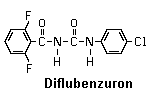 Chitin inhibitors. These chemicals (e.g., diflubenzuron and teflubenzuron) inhibit the molting process (apolysis) by blocking the activity of chitin synthetase, an enzyme needed by epidermal cells when constructing a new exoskeleton. Because of this mode of action, chitin inhibitors are highly specific to arthropods. They act rather slowly (2-5 days), but eventually disrupt any process that involves construction of new cuticle (e.g., molting, hatching, pupation). They are most effective when used against the immature stages of a pest. Diflubenzuron, currently registered under the trade name Dimilin, is used for controlling gypsy moths, boll weevils, and various other pests.
Chitin inhibitors. These chemicals (e.g., diflubenzuron and teflubenzuron) inhibit the molting process (apolysis) by blocking the activity of chitin synthetase, an enzyme needed by epidermal cells when constructing a new exoskeleton. Because of this mode of action, chitin inhibitors are highly specific to arthropods. They act rather slowly (2-5 days), but eventually disrupt any process that involves construction of new cuticle (e.g., molting, hatching, pupation). They are most effective when used against the immature stages of a pest. Diflubenzuron, currently registered under the trade name Dimilin, is used for controlling gypsy moths, boll weevils, and various other pests.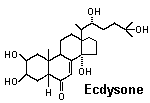 Molting Hormone Analogues. Ecdysteroids stimulate the molting process by mimicking the action of molting hormone. Applied to the surface of an insect’s body or incorporated into its food, these compounds work by initiating premature ecdysis during the immature stages of development. Ecdysteroid-like compounds have been found in some plants where they evidently serve as a defense against insect herbivores. But despite their potential as insect growth regulators, the ecdysteroids have never been developed into commercial products. Their chemical structural is similar to that of human reproductive hormones (estrogen, progesterone, and testosterone), and like many other steroid compounds, they have the potential to cause cancer and birth defects.
Molting Hormone Analogues. Ecdysteroids stimulate the molting process by mimicking the action of molting hormone. Applied to the surface of an insect’s body or incorporated into its food, these compounds work by initiating premature ecdysis during the immature stages of development. Ecdysteroid-like compounds have been found in some plants where they evidently serve as a defense against insect herbivores. But despite their potential as insect growth regulators, the ecdysteroids have never been developed into commercial products. Their chemical structural is similar to that of human reproductive hormones (estrogen, progesterone, and testosterone), and like many other steroid compounds, they have the potential to cause cancer and birth defects. Juvenile Hormone Analogues. Juvenile hormone (JH) and related compounds act as insect growth regulators by inhibiting the developmental changes associated with embryogenesis, morphogenesis, and reproduction. During normal development, JH levels are elevated in larvae (or nymphs) and decrease prior to pupation (or adult eclosion). Contact exposure to JH analogues during the egg stage or after the last larval (or nymphal) molt can inhibit development, delay maturation, and eventually result in death. Since the onset of mortality is usually quite slow (days to weeks), JH analogues have limited utility in agriculture. But several compounds (e.g., hydroprene, kinoprene, and methoprene) have been successfully incorporated into household products for controlling ants, fleas, and other household pests.
Juvenile Hormone Analogues. Juvenile hormone (JH) and related compounds act as insect growth regulators by inhibiting the developmental changes associated with embryogenesis, morphogenesis, and reproduction. During normal development, JH levels are elevated in larvae (or nymphs) and decrease prior to pupation (or adult eclosion). Contact exposure to JH analogues during the egg stage or after the last larval (or nymphal) molt can inhibit development, delay maturation, and eventually result in death. Since the onset of mortality is usually quite slow (days to weeks), JH analogues have limited utility in agriculture. But several compounds (e.g., hydroprene, kinoprene, and methoprene) have been successfully incorporated into household products for controlling ants, fleas, and other household pests. Anti-juvenile Hormones. These unique compounds (the precocenes) were first isolated in 1976 from a common houseplant (Aegeratum houstonianum). Precocenes are cytotoxic agents. They become activated by enzymes in the insect’s corpora allata, selectively destroying these glands, and preventing all subsequent production of juvenile hormone. In immature insects, exposure to anti-JH compounds may result in premature (precocious) development of adult structures or behaviors. In adults, precocenes can cause sterility because the presence of juvenile hormone is necessary for normal production of eggs and sperm. Anti-JH compounds seem to be most effective against Hemipterans. Despite their unique mode of action, these IGRs have never been developed into commercial products because they break down too rapidly in the presence of oxygen.
Anti-juvenile Hormones. These unique compounds (the precocenes) were first isolated in 1976 from a common houseplant (Aegeratum houstonianum). Precocenes are cytotoxic agents. They become activated by enzymes in the insect’s corpora allata, selectively destroying these glands, and preventing all subsequent production of juvenile hormone. In immature insects, exposure to anti-JH compounds may result in premature (precocious) development of adult structures or behaviors. In adults, precocenes can cause sterility because the presence of juvenile hormone is necessary for normal production of eggs and sperm. Anti-JH compounds seem to be most effective against Hemipterans. Despite their unique mode of action, these IGRs have never been developed into commercial products because they break down too rapidly in the presence of oxygen.